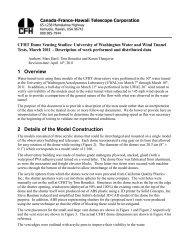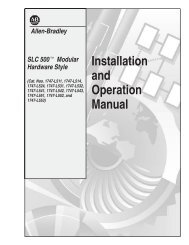Documentation [PDF] - Canada France Hawaii Telescope ...
Documentation [PDF] - Canada France Hawaii Telescope ...
Documentation [PDF] - Canada France Hawaii Telescope ...
You also want an ePaper? Increase the reach of your titles
YUMPU automatically turns print PDFs into web optimized ePapers that Google loves.
Figure 9: Growth curves for PSF models in the L99 r-band exposures using MAG_SNLS and IQ20 magnitudes<br />
to estimate the total magnitudes (left and right panels respectively). Each line corresponds to the difference in<br />
magnitude between the total flux and the flux at the stated aperture size (measured as a multiple of the FWHM) for<br />
each L99 exposure. As expected, when using the IQ20 aperture, the scatter at 40×FWHM is considerably reduced<br />
(right panel<br />
the measured MAG_SNLS and the measured IQ20 magnitude. This aperture correction is plotted against<br />
the image quality in Figure 10. It is important to note that the behavior in the regime of very good image<br />
quality clearly departs from a constant aperture correction.<br />
For images taken in excellent seeing, the SNLS aperture is too small to capture the same flux versus total<br />
flux compared to poorer image quality, which makes the basic SNLS aperture photometry not reliable<br />
for our calibration. Figure 11 shows the shape of the PSF for two different FWHM rebined to the same<br />
size. One can clearly notice that the overall shape is different : a boxy shape at good IQ due to flux in the<br />
spikes and a very symmetrical shape at larger IQ. A tangible explanation of the behavior of the aperture<br />
correction at low FWHM is the flux contained in the spikes which scale differently than the bulk of the<br />
flux of the PSF.<br />
3.7.3 Derivation of the MAG_IQ20 magnitudes<br />
Measuring the flux inside a large aperture of 20 × FWHM is not a trivial task in the naturally deep CFHTLS<br />
stacks where objects are subject to crowding. Instead we chose to model the aperture correction on a per<br />
stack basis to go from the robust, but biased, MAG_SNLS to the nearly total magnitude MAG_IQ20.<br />
The use of a master PSF model per image is adopted to ensure a robust estimation of the IQ20 aperture<br />
magnitudes. First a pixel-based model of the PSF is constructed using the PSFex software (Bertin, 2011)<br />
using a large set of stars. From this PSF model (which is produced as a FITS image) the fluxes inside a<br />
series of apertures are computed using SExtractor. The aperture correction (ApCorr) is defined as the<br />
magnitude difference between the flux inside the SNLS and IQ20 apertures:<br />
ApCorr = −2.5 × log 10<br />
Flux(Ap SNLS )<br />
Flux(Ap IQ20 )<br />
(2)<br />
Since photometric rescaling from L99 to the CFHTLS stacks is carried out on only 25% of the MegaCam<br />
field of view, a unique PSF model is computed for each of the four quadrants of each L99 image. Despite<br />
15


![Documentation [PDF] - Canada France Hawaii Telescope ...](https://img.yumpu.com/26965302/27/500x640/documentation-pdf-canada-france-hawaii-telescope-.jpg)









